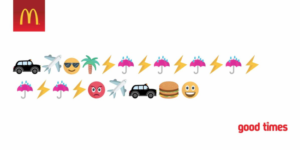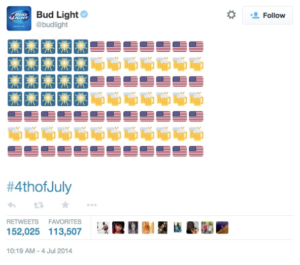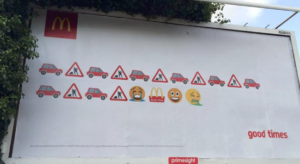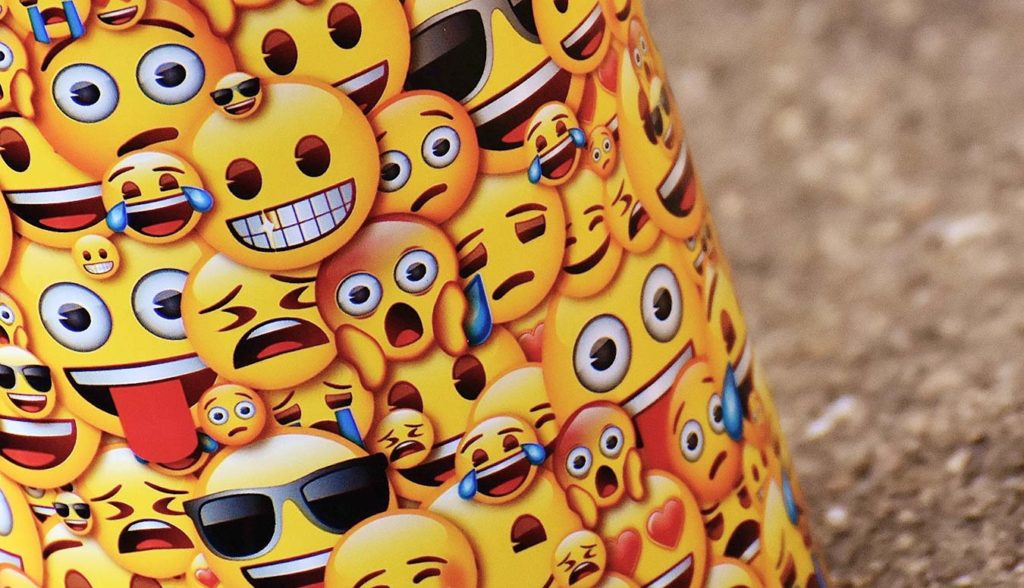Right now, there are 2,823 emojis in the Unicode Standard.
The most popular emojis on Twitter as I’m posting this article are 😂, followed by ❤.
Over 60 million emojis are sent each day on Facebook.
It’s the way people talk in private and public messages, so it makes sense that it’s part of our everyday in other ways, too.
As I mentioned in my last post, emojis are everywhere, from our greatest literature to our press releases. They’re a new visual language that can have positive impacts on even our businesses messages. We’re even forming a new grammar around them.
But tapping into this power for commercial purposes takes a little bit more thought than that conversation you have with your mom.
Here are nine effective ways companies have used emojis to get their message get across:
1. Enhance understanding
Not only can emojis help reinforce key words and thoughts in your messages, but they can also teach. GE produced a series called Emojiscience, for example, which breaks down the science behind evolution, climate change, and holodecks in easy-to-understand terms (with the help from Bill Nye, so you know it’s awesome):
2. Add a little humour
Let’s face it, these little pictures are fun. And sometimes funny. (A little laughter goes a long way, after all.) In my last post, I mentioned this Deadpool movie billboard. It captured a lot of attention, and even famous comedians jumped on Twitter to share:
This idiotic/brilliant billboard is why I’m all in on the DEADPOOL movie. I’m an easy lay. pic.twitter.com/jSRorPvaCp
— Patton Oswalt (@pattonoswalt) January 13, 2016
3. Tell a story
It’s not just Emoji Dick. In the grammar of emoji, messages are read left-to-right like words (in cultures where reading left-to-write is a thing). That leaves open all kinds of possibilities in creating a linear sequence of events, stories and vignettes, like McDonalds did with their “Good times” campaign:

4. Create a sense of achievement
Remember those pictogram puzzles from grade school, where words (or parts of words) were replaced with images? If you were like me, you felt like a superstar detective when you solved one. We feel accomplishment when we unravel puzzles – even simple ones – and come out with a delightful surprise on the other end (like that Deadpool campaign or that McDonald’s story).
5. Convey emotion
When we talk in person or over video, we have the context of vocal tone, eye contact and body language. In text, not so much. Emojis – especially the faces – help fill in those blanks when words are all we have.
6. Break up a wall of text
We all know our eyes glaze over when we read large blocks of text. We take in maybe the first few words, scan for key words, numbers or formatting differences, then move on. Emojis are a great way to help a short attention span stay tuned in and provide relief from heavy reading.
7. Make art
Sometimes it pays to get extra creative. I’m not sure how long it took NASCAR to put together these all-emoji, mosaic-style portraits of famous drivers for World Emoji Day, but they were well worth the time:

Ditto for this very patriotic Fourth of July tweet from Budweiser:

8. Make good use of limited space
Sometimes we have very little space to get an important message across, like push notifications on your phone’s lock screen. When character count matters, you can save vital real estate by using emoji in place of words. They increase notification open rates by about 85 per cent and conversions by nine per cent, found one report published by HubSpot.
9. Do something
Did you know you can order pizza simply by sending a pizza emoji to Domino’s via Twitter? Or that, during the WWF’s #EndangeredEmoji campaign, you could turn emoji use into a charitable gift? They’re doing real work, in real life.
Read this before you throw emoji on everything
If you’re itching to use emojis in your campaigns, cool! But proceed with caution, because it’s not always a success story. That little voice in the back of my head compels me to arm you with the following caveats:
Put your message first. If emojis don’t serve it in some way, it’ll seem like an inauthentic attempt to get attention. Or worse – you’ll just confuse your readers.
Don’t go too far. There’s a reason Chevy went under fire after their Cruze press release. It was just too difficult to decipher, and went a little too far in a “let’s appeal to more millennials” kind of way. “Use them sparingly” is a good rule (unless you’re making art, of course).
Different people interpret them differently. Is that face blissfully happy or ready to fight? A study from the University of Minnesota found 25 per cent of people shown the same face emojis disagreed on the sentiment and meaning.
Some are more ambiguous than others. In a New York Post article, a woman recounts an exchange she had with her supervisor when her train derailed on her way to work. He sent two emojis: “One was a pile of poop; the other was a clock. ‘What the f - - k?’ I remember thinking,” she told the reporter. (He really meant “bad timing” but it just wasn’t clear to her.)
Some are more effective than others. And which ones perform best will depend on your audience and your message. Yes, the heart is one of the most popular emoji, but will that make you stand out? The octopus is much less common, but will it work with your content? HubSpot recommends you test which ones are most effective and follow those trends.
Oh, and that McDonald’s campaign? All it took was one graffiti artist who added a barfing face after the final emoji to reverse that message.

Even the best ideas can bite back when you aren’t careful.
